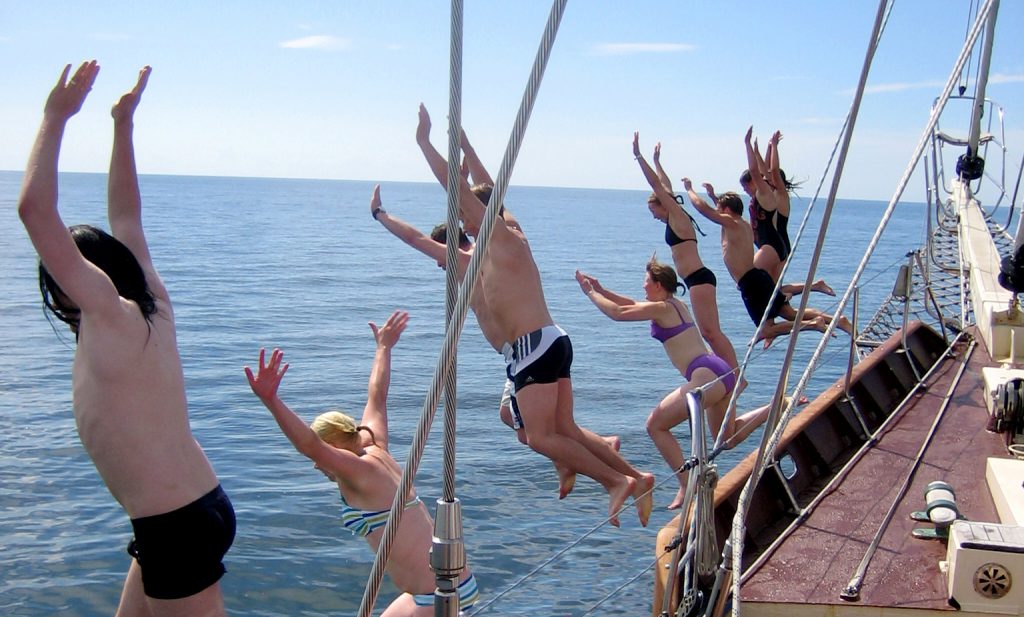What young people REALLY want… the inside knowledge of how to recruit trainees
At the International Sail Training and Tall Ships Conference in Bordeaux 2017 a large group of ‘old’ people were asked by ‘young’ people what they REALLY wanted when they were younger… ! The responses ranged from girlfriends/boyfriends, freedom, going out and parties to having a career, getting good grades and making money!
The ‘old’ audience were reliably informed by the Sail Training International Youth Council that young people today are actually quite a sensible bunch. What’s most important to them is popularity, family, jobs, education and love. So, showing them the benefits of doing something out of the ordinary – such as the obscure idea of sailing on a Tall Ship – can be difficult, especially with so many conflicting influencing factors. So – to recruit trainees there are a number of challenges that need to be overcome first.
Helping to build relationships both before, during and after a voyages means trainees will keep coming back. So, the argument was put forward that potential trainees can be influenced through the classic decision making phases of 1 pre purchase, 2 during purchase and 3 post purchase.
This blog reports on the findings of the STI Youth Council on how these phases work and how it is possible to address them, in order to enthuse a new audience of young trainees.
PHASE 1: Pre-Purchase
Appeal to the decision maker
Your target audience – young trainees – are not necessarily the decision maker. The biggest influencer and motivator is family, closely followed by school programmes and then Google!
Creating marketing content that appeals to both young people AND the decision maker, is key to helping attract more people to sailing onboard your vessel. There are A LOT of benefits to going sail training which will appeal to both audiences. The deal breakers are cost, time, intimidation, lack of skills and not seeing the benefits.
Make sure the cost is clear and up front; cost can be a big factor in the decision making process, but it’s not a deal breaker, especially for parents and family who may be funding, or part-funding, the voyage.
Explaining exactly how much the voyage will cost and how young people can raise the funds will help potential trainees, or decision maker, to make a decision. They might be able to apply for a host port trainee place, fundraise themselves, apply for a bursary, or friends and family may be able to contribute towards the cost of the voyage. Making these options and opportunities clear and showing how they can be tackled will make all the difference.
Make sure trainees expectations of a voyage meet the realities they will face…
Level expectations: reality vs constructed reality
Levelling the expectations of people looking to go sail training is an important consideration, if someone takes part in a sail training adventure expecting a luxury cruise, they are going to be disappointed. A successful recruitment process is about reflecting the realities of what sail training is all about.
Make sure they know that they will work hard, might feel sea sick, be deprived of sleep, learn new skills, face challenges and meet a wide range of new people, whilst working as a team to get things done. Cleaning, maintenance and watch keeping can be a lot of fun – but in reality it’s not all about the sunsets and dolphins.
As the Youth Council said “Sail Training takes you into a new environment, surrounded by people you don’t know, forces you outside of your comfort zone and makes you do things you don’t want to do.” The biggest challenge a new trainee needs to face is – are they prepared to step outside of their comfort zone?
Make sail training instant
Instant gratification is something that young people look for in their daily lives. One click delivery and downloading books or music, instead of walking into a shop, are just a couple of examples. Social media also offers instant gratification to its users. You can post a status or message someone in seconds and get a reaction or reply almost instantly.
Young people often believe that sailing isn’t for them because it’s not instant. One way to help tackle this perception is to use social media platforms to promote what sail training is about – use videos with music, inspiring photos with motivating captions. This will help young people to understand sail training in a format that’s familiar to them, and it will help them to decide to go on a voyage.
Phase 2: During Purchase
Look after your trainees
Once you have them on board it’s important to really look after your trainees so they enjoy the experience and leave you wanting more. These are some of the questions they will be asking themselves on board…
“Do I feel welcome?”
This could be something as simple as make friendly contact before the trip with lots of joining information, and welcoming them when they come onboard – showing them around and where they are sleeping; showing them where to put their bags and introducing them to other people. A structured pre-voyage engagement programme that can be sent out before they even step on board, will help trainees feel prepared and more engaged with the vessel and its operators. A kit list should be sent out as part of this that includes key items and items specific to the vessel. This will be invaluable and will ensure trainees arrive fully prepared and looking forward to enjoying themselves during the voyage.
“Do I feel like part of the group?”
Icebreaking games and challenges are a great way to make trainees feel welcome and to help them socialise and interact with the other trainees. It’s a good idea to have these icebreakers and challenges alongside daily tasks that need to be performed onboard a vessel. This allows trainees to learn something new, and helps them to bond with each other and with the crew while having fun.
“Do I understand?”
Sailing for the first time can be a daunting prospect. Giving clear, easy to understand instructions, about the way the ship is run is very important. Making sure any potential language barriers are addressed is another key aspect. You can provide the best instructions to any task, but if they are delivered in a foreign language and some people don’t understand it’s pointless. Even if you can’t translate you should ask around the crew to find someone who can. Find translation buddies for everyone who needs one!
“Am I enjoying myself?”
There is no reason why anyone can’t enjoy themselves on board. Making sure that trainees are aware that there will be fun activities as well as daily duties, will mean they are more likely to enjoy themselves. If they feel welcome, part of the group and they understand, then this will help them to enjoy and engage with the voyage and they are more likely to recommend the experience book again.
Phase 3: Post-Purchase
When a voyage ends trainees often don’t know where to go afterwards, or they are encouraged by their parents to “grow up” and find a job. This is often because they aren’t aware that there are always new skills to learn with sailing and good careers to be had at sea. It can also be because they feel it would be a further investment of time and money which they no longer have.
Apply skills to the real world
Employability and education are just two of the key issues facing young people. It’s important to emphasise that a sail training voyage is an education and provides trainees with key skills that are applicable to employment. And if they really loved it, then there are career opportunities in the maritime industry. But it’s not just them you’re convincing, it’s also the parents and family who are probably pushing them to go out and find a ‘proper’ job. Showing how sail training skills can applied to the real world will help convince them that the sail training voyage was a very good idea.

Trainees often struggle to justify sacrificing the time and money required to undertake subsequent sail training voyages.
Keep in contact
Depending on their age and what stage trainees are at with their education or careers, they may not have time to go on another two week sailing voyage again. It might be that they can’t afford it or they’ve moved on to other things. But, making trainees aware that they can still get involved with the ship in some way, through weekly events or just helping out onboard when the ship is in port, will be invaluable. This can be achieved by maintaining communication with trainees after they disembark with a WhatsApp group so they are aware of all available opportunities and can start to generate their own activities in support of the vessel.
Sail Training International also has Facebook, Instagram and Twitter accounts they can follow and also a Facebook Group, which is an alumni of previous trainees and a good place to keep in contact and share stories, photos and videos.
We hope these approaches will help you to successfully recruit and retain more young people as trainees onto your ships. It will also help to promote sail training more generally, gather interest and ultimately persuade young people that going on a sail training voyage REALLY is something which they want to do!


